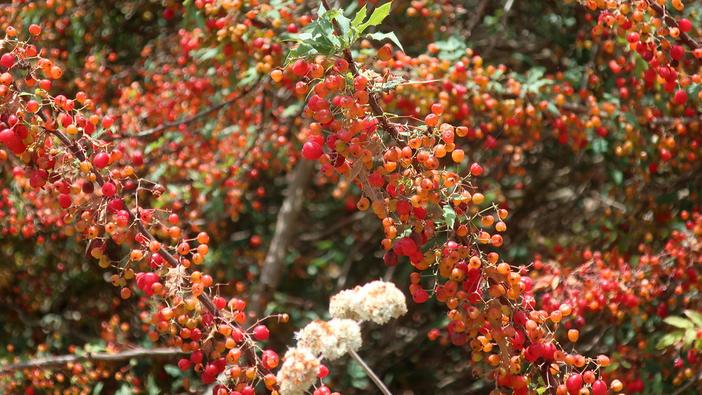Nevin’s Barberry
(Berberis nevinii)
Nevin’s Barberry (Berberis nevinii)
/
/

cultivar413
CC BY 2.0
Image By:
cultivar413
Recorded By:
Copyright:
CC BY 2.0
Copyright Notice:
Photo by: cultivar413 | License Type: CC BY 2.0 | License URL: https://creativecommons.org/licenses/by/2.0/ | Uploader: cultivar413 | Publisher: Flickr










































Estimated Native Range
Summary
Berberis nevinii, commonly known as Nevin’s barberry, is an evergreen shrub native to the chaparral and coastal sage scrub of Southern California, particularly adapted to dry, rocky slopes and canyons. It is a member of the Berberidaceae family and can reach up to 4 meters (13 ft) in height. Nevin’s barberry has a dense foliage of dark green to bluish-green, spiny-toothed, spear-shaped leaflets, which contribute to its striking appearance. The shrub produces racemes of 3 to 5 bright yellow, cup-shaped flowers that are layered and quite showy, blooming in spring between March and April. Following the flowering season, it bears spherical reddish berries that appear in bunches and mature to a dark blue in the summer.
Nevin’s barberry is valued for its drought tolerance and its ability to thrive in full sun or part shade with minimal water requirements, making it suitable for xeriscaping and water-wise gardens. It is also appreciated for its ornamental qualities, including its vibrant yellow flowers and attractive berries, which can provide food for local bird species. In cultivation, it is used for habitat restoration, as a hedge or screen, and in native plant gardens. While it is generally low-maintenance, it is important to plant it in well-draining soil to prevent root rot. There are no major disease issues, but it can be susceptible to fungal infections if conditions are too moist.CC BY-SA 4.0
Nevin’s barberry is valued for its drought tolerance and its ability to thrive in full sun or part shade with minimal water requirements, making it suitable for xeriscaping and water-wise gardens. It is also appreciated for its ornamental qualities, including its vibrant yellow flowers and attractive berries, which can provide food for local bird species. In cultivation, it is used for habitat restoration, as a hedge or screen, and in native plant gardens. While it is generally low-maintenance, it is important to plant it in well-draining soil to prevent root rot. There are no major disease issues, but it can be susceptible to fungal infections if conditions are too moist.CC BY-SA 4.0
Plant Description
- Plant Type: Shrub
- Height: 8-12 feet
- Width: 8-12 feet
- Growth Rate: Moderate
- Flower Color: Yellow
- Flowering Season: Spring
- Leaf Retention: Evergreen
Growth Requirements
- Sun: Full Sun, Part Shade
- Water: Low
- Drainage: Medium
Common Uses
Bee Garden, Bird Garden, Butterfly Garden, Deer Resistant, Drought Tolerant, Erosion Control, Low Maintenance, Showy Flowers
Natural Habitat
Native to the chaparral and coastal sage scrub of Southern California, particularly on dry, rocky slopes and canyons
Other Names
Common Names:
Scientific Names: , Berberis nevinii, Mahonia nevinii, Alloberberis nevinii, Odostemon nevinii,
GBIF Accepted Name: Alloberberis nevinii (A.Gray ex A.Gray & S.Watson) C.C.Yu & K.F.Chung